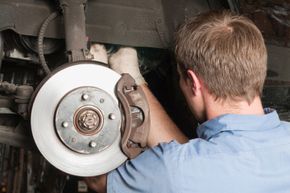Though you might not be equipped to handle a brake job (after all, you're taking your life in your own hands), anyone who's willing to get a little greasy can chase down the source of a brake problem -- or at least get close. At best, you'll learn what to look out for when you hear that telltale clunk; at worst, you'll have some idea when your mechanic's taking you for a ride. Before you try complex tests without expensive tools, you can get an idea of the brake system's overall condition with a few observations.
Check brake pads specifically for uneven wear, which could indicate the brake pistons or calipers getting stuck. Braided brake lines, in which the tube is wrapped with woven steel mesh to provide support, are popular for both durability and aesthetics. If your car has braided lines, check them extra carefully. Though they're stronger, any damage will be much harder to see. Brake lines should be flexible yet firm; brittle or slack hoses need to be replaced, because they're prone to cracks and leaks. Also, check brake fluid levels -- low levels might indicate leaks.
Advertisement
Take a look at your connections, handling them gently. Any loose connections might alert you to a worn part or potential leak. Leaks are particularly dangerous to a car's brakes; if something's off anywhere in the system, it indicates that the pressure has been compromised, which can lead to comprehensive, overall failure. Brake fluid is also notoriously corrosive and slippery, and a leak, almost anywhere, will allow it to escape from the system. Any parts that have been contaminated with brake fluid or otherwise unidentifiable drips, especially those that are responsible for friction, should be replaced.
The following spots are easy to check for leaks and general problems. If you need help locating them, try checking your owner's manual or repair guide.
- brake backing plate
- brake hoses
- brake tubing
- connections
- auxiliary valves
- master cylinder
Not all brake components can be evaluated with a simple glance, but it's worth learning to check the rest of the system. Brake pedal travel is another easy barometer. Excessive pedal travel means the brake pad is situated too far from the rotor, which indicates rotor runout (uneven surface damage to the rotors) or loose wheel bearings. Sometimes, excessive pedal travel points to a buildup of air in the brake lines. Check brake pedal travel by removing the floor mat and pulling back the carpet. With the engine running and pedal depressed, measure the distance between the top of the pedal and the pad beneath your foot, and check your results against your car's repair manual recommendations.
Another measurement: brake free play, which should be between 0.4 and 0.12 inches (1 and 3 millimeters). If it's less, the brakes can overheat and wear down. Measure free play after pumping the brakes several times with the engine off. You're looking for the distance between the pedal at rest and in the depressed position.
Some of the car's parts and problems might appear unrelated to the brakes, but you might find that that's not the case at all. For example, as the suspension jostles around, it affects the wheels' movement, which in turn affects the brakes. You have to get underneath the car to really check the suspension. Look for leaks, especially at boots (sheathes that cover other parts). Keep in mind that vibrations from worn suspension components can transmit through the brakes, hiding the real problem. Suspension problems can also cause uneven or premature brake wear.
Of course, the best time to deal with brake problems is before they happen. These methods are a solid overall primer, but applying the techniques might require more in-depth mechanical experience. Not to worry -- the next page will point you in the right direction.
Advertisement



